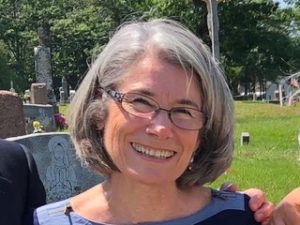Why Rituals Are Important, Pt. 2
January 1, 2022In the previous post, we discussed the importance of rituals, of gathering as a group. Whatever the nature of the gathering—a church service, to something much smaller and less informal—there is great comfort in coming together with others to think about the person we’ve lost, and talk about the person we’ve lost, and see other people grieving just as we are grieving.

Mary Gallagher
Grief, as we said, is a communal experience, not a solitary one. Doing it in the presence of people we are close to brings us great comfort, and helps us process the loss, and start to cope.
The trouble is, many people, when they come to a funeral home, believe that they have only two choices when it comes to a service: A religious service, or no service at all. Many choose the latter.
Fortunately, though, there is a third option: a celebrant service. This is a gathering that can be held in a funeral home, or at the cemetery, or in a hall: pretty much anywhere. It satisfies the deep human need to grieve with others, but it also offers a great deal of flexibility and creativity in terms of what the service will be.
Keohane’s frequently works with a wonderful woman named Mary Gallagher. She has been a celebrant for nearly a decade, helping families craft the right service for them. “It’s all about listening to people and meeting them where they are,” she says.
The process starts with a great deal of storytelling. Families come in, and talk about the person they’ve lost: what they were like, what life meant to them, and what they meant to the survivors. “There might be a little crying,” Mary explains. “But a lot of times it’s just a lot of laughing, and enjoyment, and back and forth.” These exchanges help give her a better sense of who the person was, so she can honor them in a way that rings true. But it also gives the family the opportunity to talk about them in a nurturing, confidential environment, which helps bring comfort and closeness.
Next, Gallagher leads the family in a discussion of the person’s spirituality. Were they religious, or spiritual, or completely secular? What did they believe comes after life? Some believe in Heaven, some believe life simply ends when it ends, some fall some aren’t sure. But knowing that helps Gallagher craft the service. She works with the families to select readings: prayers, blessings, or poems that help capture the person being mourned. She does the same with music. Were there songs that were particularly meaningful to the deceased? If not, Gallagher has a wealth of resources to find the right music to honor the occasion.
There’s no one way to perform these services. Every one of them is personalized, and unique. Most involve an introduction by Gallagher, talking about the threads of the person’s life, what it meant to them and to others. Some involve family and friends coming up to tell stories, some open the floor to everyone. There are readings, and music. And there’s closing. “That lets people leave, feeling supported that the person is in a good place,” she says. “Even if it’s only in memory, they’re in a good place.” And she almost always ends with a song.
These services, Mary explains, are powerful and healing. “They help a circle of people tap into healthy kind of grieving,” she says. “They remind people, ‘Don’t stop saying that person’s name. If you love someone, you don’t want to think that everybody’s forgotten them. Keep saying their name. Keep telling their stories.”
Hearing so many of these stories over the years has been wonderful for Mary, too. “That’s kind of why I love doing it,” she says, “because it really gets to the heart of who people are.”
Leave a Comment